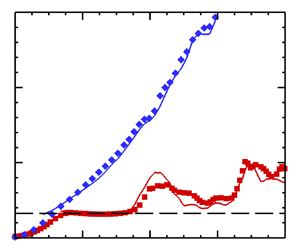Published online by Cambridge University Press: 03 January 2023

The highly nonlinear evolution of the single-mode stratified compressible Rayleigh–Taylor instability (RTI) is investigated via direct numerical simulation over a range of Atwood numbers ( $A_T=0.1$–
$A_T=0.1$– $0.9$) and Mach numbers (
$0.9$) and Mach numbers ( $Ma=0.1$–
$Ma=0.1$– $0.7$) for characterising the isothermal background stratification. After the potential stage, it is found that the bubble is accelerated to a velocity which is well above the saturation value predicted in the potential flow model. Unlike the bubble re-acceleration behaviour in quasi-incompressible RTI with uniform background density, the characteristics in the stratified compressible RTI are driven by not only vorticity accumulation inside the bubble but also flow compressibility resulting from the stratification. Specifically, in the case of strong stratification and high
$0.7$) for characterising the isothermal background stratification. After the potential stage, it is found that the bubble is accelerated to a velocity which is well above the saturation value predicted in the potential flow model. Unlike the bubble re-acceleration behaviour in quasi-incompressible RTI with uniform background density, the characteristics in the stratified compressible RTI are driven by not only vorticity accumulation inside the bubble but also flow compressibility resulting from the stratification. Specifically, in the case of strong stratification and high  $A_T$, the flow compressibility dominates the bubble re-acceleration characters. To model the effect of flow compressibility, we propose a novel model to reliably describe the bubble re-acceleration behaviours in the stratified compressible RTI, via introducing the dilatation into the classical model that takes into account only vorticity accumulation.
$A_T$, the flow compressibility dominates the bubble re-acceleration characters. To model the effect of flow compressibility, we propose a novel model to reliably describe the bubble re-acceleration behaviours in the stratified compressible RTI, via introducing the dilatation into the classical model that takes into account only vorticity accumulation.